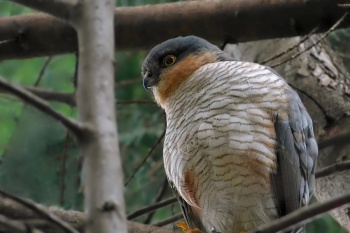- Accipiter nisus
Identification
Male
- 29-34 cm (11 inches) long with a 59-64 cm (23-25 inches) wingspan
- Slate-grey upperparts
- Barred reddish underparts
Female
- 35-41 cm length and a 67-80 cm wingspan
- Barred grey underparts
Juvenile brown above and barred brown below
All have a white supercillium, more noticeable in the adults
Similar Species
The female can be confused with the Eurasian Goshawk. This differs as follows:
- larger, more bulky
- in flight adult has largely unbarred inner secondaries
- flared "hips"
- rounded tail corners giving tail round ended rather than square ended appearance
- longer neck, but proportionately smaller head
- extensive fluffy white under tail coverts sometimes apparent
- flight not undulating
- slightly more pointed wings (usually not obvious)
- much stronger and thicker legs (usually not apparent)
Distribution
Europe and north Africa to eastern Asia.
Europe: the most numerous and widespread Accipiter found almost throughout the region except for Iceland and the far north of Scandinavia and Russia. In the south breeds on the western Canary Islands, across North-West Africa and on Corsica, Sardinia and Sicily. Also breeds throughout Greece and Turkey (except much of the central plateau) and east to the Caspian. In the Middle East may breed regularly in Israel but rare.
Asia: Breeding in Himalayas and Siberia to eastern Asia.
Northern birds are migratory with known wintering grounds to Africa, India, Sri Lanka and Indochina. Over most of Europe this is a rather sedentary species. Winter visitor or passage migrant to much of Turkey; the Middle East and North Africa. Small numbers occur on passage at Gibraltar and the Bosphorus but much larger movements can be seen at Falsterbo. Peak periods here are mid August-mid November and April-early May.
Taxonomy
Subspecies
There are 6 subspecies[1]:
- A. n. granti: smaller and darker than the nominate race
- A. n. nisus:
- Europe to Asia Minor and Siberia; winters to Africa
- A. n. wolterstorffi: smaller and very much darker than nominate race
- A. n. punicus: a large, pale race
- A. n. nisosimilis:
- A. n. melaschistos:
- Himalayas and mountains of central Asia
Habitat
Deciduous, mixed or coniferous woodland with adjacent open country. In recent years with decreased persecution has become commoner close to human habitation and is now moving into towns. In winter often found far from woodland, hunting along hedgerows in open farmland or in coastal areas.
Behaviour
It hunts birds in woodland or cultivated areas, relying on surprise as it flies from a perch or hedge-hops to catch its prey unaware.
Diet
Their main diet consists of small and medium sized birds, but they will also catch small rodents such as mice.
Flight
The flight is a characteristic "flap – flap – glide".
Breeding
This species nests in trees, building a new nest each year, often utilising the abandoned nest base of another species, such as crow or even a squirrel's drey. There is a single clutch of 4-6 eggs, which are whitish, with maybe a blue or green tinge and are heavily marked with reddish brown spots and blotches.
Young female sparrowhawks disperse about twice as far from the nest as the male sparrowhawks; this is possibly an adaptation to avoid inbreeding[2].
In Denmark, male sparrowhawks have a higher mortality than females during their first year of life, while the reverse is the case in following years.
Vocalisation
References
- Clements, J. F., P. C. Rasmussen, T. S. Schulenberg, M. J. Iliff, T. A. Fredericks, J. A. Gerbracht, D. Lepage, A. Spencer, S. M. Billerman, B. L. Sullivan, and C. L. Wood. 2023. The eBird/Clements checklist of Birds of the World: v2023. Downloaded from https://www.birds.cornell.edu/clementschecklist/download/
- Paper in DOFT read December 2008
- Animal Pictures Archive
- The Observer's Book of Birds' Eggs
- Handbook of the Birds of the World Alive (retrieved March 2015)
Recommended Citation
- BirdForum Opus contributors. (2025) Eurasian Sparrowhawk. In: BirdForum, the forum for wild birds and birding. Retrieved 26 April 2025 from https://www.birdforum.net/opus/Eurasian_Sparrowhawk
External Links
GSearch checked for 2020 platform.1






